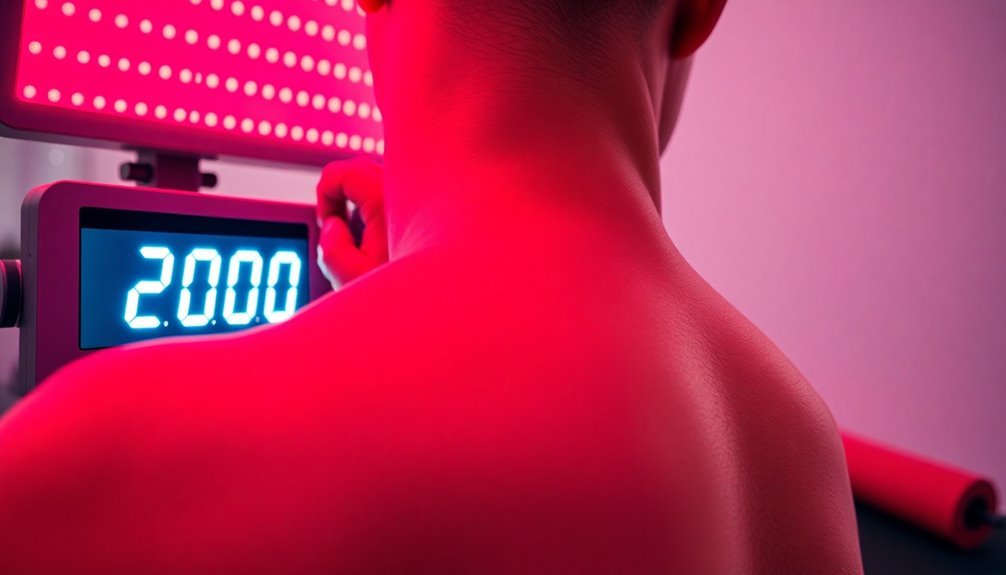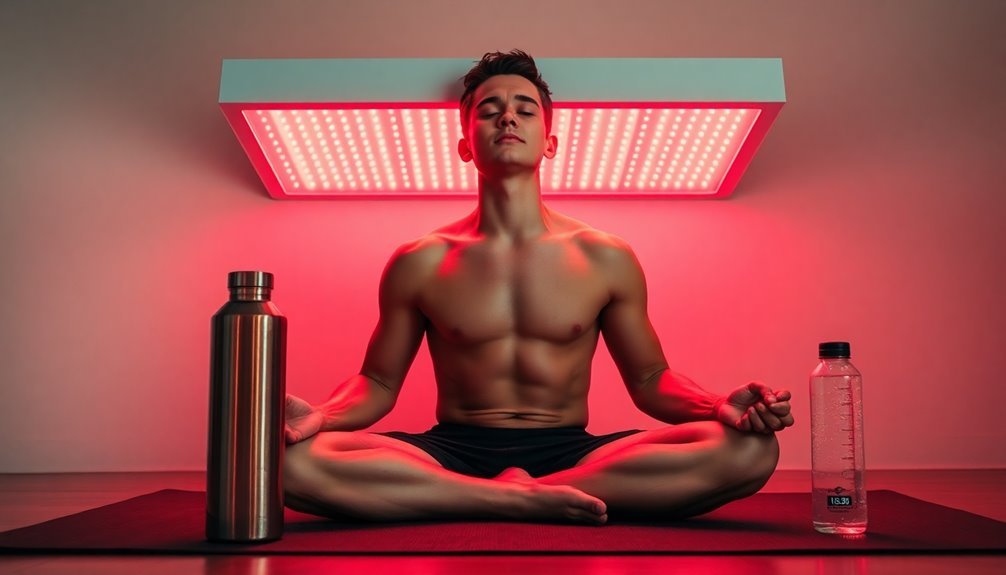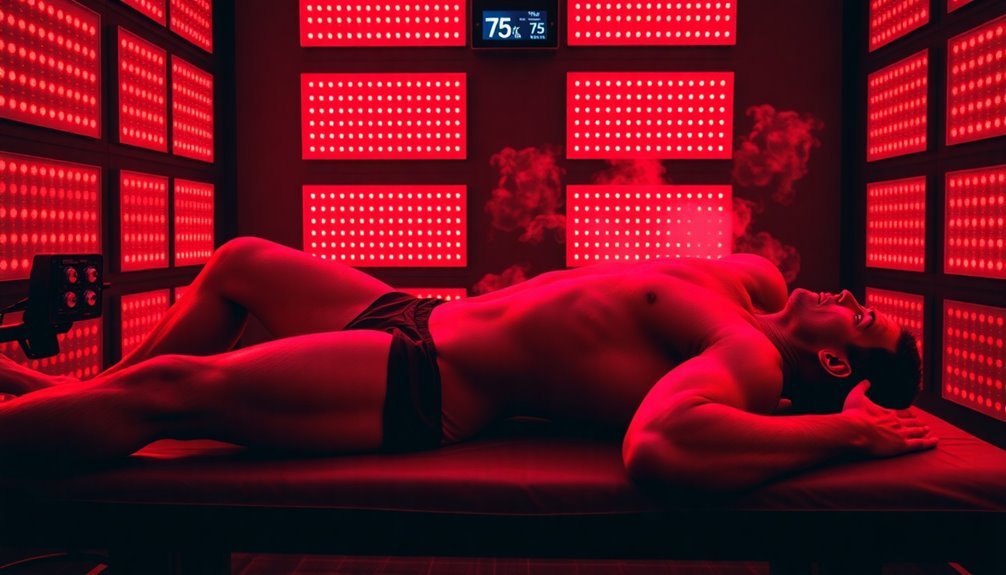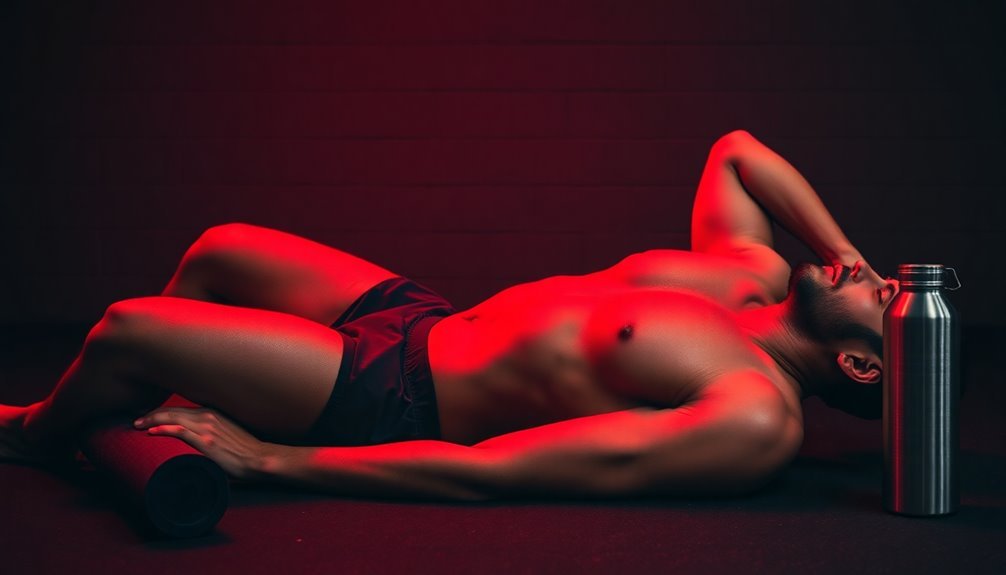Maximize your post-workout recovery with red light therapy by timing sessions within 20 minutes after exercise when inflammation peaks. Target large muscle groups first, positioning the device 6-8 inches away for 10-20 minutes. Stay well-hydrated by drinking 16-24 ounces of fluid per pound of water weight lost. Combine therapy with gentle movement like walking or light stretching to boost circulation. Start with lower intensities and gradually increase as your body adapts. Schedule 3-5 regular sessions weekly, aligned with your workout routine. Monitor your body's response through reduced soreness and improved heart rate recovery. These foundational tips just scratch the surface of red light therapy's recovery benefits.
Timing Your Red Light Sessions

When planning your red light therapy routine, timing plays a crucial role in maximizing its benefits for exercise performance and recovery. For ideal results, you'll want to think about both pre- and post-workout sessions, as each offers distinct advantages.
If you're aiming to prevent injury and boost endurance, schedule your therapy 3-6 hours before your workout. A brief 3-5 minute session can increase blood flow and cellular energy, preparing your muscles for exercise. Using LED light technology, you can achieve enhanced ATP production in your muscle cells. You'll likely experience less fatigue and muscle strain during your workout.
For post-workout recovery, start your red light therapy immediately after exercising. This timing helps reduce muscle soreness and inflammation while accelerating the repair process.
You can extend these sessions to 6-20 minutes, depending on your workout intensity and recovery needs.
For maximum benefits, think about implementing both pre- and post-workout sessions, especially if you're engaging in high-intensity training. Aim for 3-5 sessions per week, adjusting the frequency based on how your body responds.
Remember to keep your doses around 60 Joules per session for ideal results, and maintain consistency in your routine to achieve the best recovery outcomes.
Target Major Muscle Groups First
Start your red light therapy session by focusing on your legs, back, and core muscles since they're the largest muscle groups and typically experience the most stress during workouts.
You'll want to give these areas priority treatment because they contain more muscle mass and require more energy for recovery than smaller muscle groups.
Once you've treated these major areas, you can move on to smaller muscle groups like arms and shoulders for a complete recovery routine. The deep penetration of red and near-infrared light ensures optimal ATP production in these large muscle groups for enhanced recovery.
Prioritize Legs and Back
Post-workout muscle recovery demands strategic attention to your largest muscle groups first. When applying red light therapy, focus on your legs and back, as these areas contain the most substantial muscle mass and typically experience the most strain during exercise.
Position the red light device 6-8 inches from your thighs, hamstrings, and calves for 10-20 minutes, ensuring the diodes deliver 60-300 joules of energy.
For your back muscles, maintain the same distance and duration, targeting both the upper and lower regions. Dynamic stretching routines before red light therapy sessions can enhance flexibility and prevent muscle stiffness.
You'll want to stay properly hydrated throughout the process to maximize the therapy's effectiveness.
Schedule your therapy sessions strategically. If you're strength training, apply the treatment 5-10 minutes before your workout.
For endurance activities, use it both before and after exercise.
Combine this therapy with foam rolling and gentle stretching to enhance recovery benefits. You'll notice reduced muscle soreness and decreased inflammation markers in your blood, particularly lactate and creatine kinase levels.
Remember to maintain consistency with your sessions rather than using the therapy sporadically. Aim for at least three sessions weekly, focusing on these major muscle groups to optimize your recovery process and maintain training intensity.
Core Before Extremities
Before applying red light therapy to your limbs, prioritize your core region, as these central muscles form the foundation of your body's strength and stability. Your core muscles play a vital role in every exercise, transferring energy from your midsection to your extremities.
By targeting your core first during recovery, you'll enhance the effectiveness of your overall healing process. Research shows that training early yields results, making this approach particularly beneficial for recovery protocols.
Training your core at the beginning of workouts leads to better performance, and the same principle applies to recovery. When you focus red light therapy on your core area first, you're supporting the muscles that maintain spine stability and prevent injury during heavy lifts. This approach helps create a solid foundation for healing other muscle groups.
- Target abdominal muscles and lower back first to support overall muscular recovery
- Focus on areas engaged during planks and functional core movements
- Pay special attention to regions stressed during compound exercises
- Include obliques and deep core muscles in your treatment sequence
Remember that your core isn't just about abs – it's a complex network of muscles that supports every movement you make. Prioritizing these central muscles during red light therapy sessions helps optimize your body's recovery process and maintains the strength gains from your workouts.
Stay Hydrated During Treatment

While engaging in red light therapy after your workout, proper hydration remains essential for maximizing its benefits.
You'll want to start by drinking 8-20 ounces of fluid about an hour before your session, followed by another 8-10 ounces just 15 minutes prior to treatment. This pre-hydration strategy helps prepare your body for the heat exposure during therapy. Consuming a balanced pre-workout meal 3-4 hours before exercise will help optimize your energy levels throughout your workout and therapy session.
During your red light therapy session, aim to drink 4-6 ounces of water every 15 minutes, especially if you're coming straight from a workout. You'll need to replace fluids lost through sweating, but don't overdo it – excessive hydration can lead to hyponatremia. Keep an electrolyte-rich drink nearby to maintain proper mineral balance.
After your session, focus on strategic rehydration within the first hour. You should consume 16-24 ounces of fluid for every pound of water weight lost during exercise and treatment. Consider incorporating chocolate milk or an electrolyte beverage to replenish both fluids and nutrients.
Monitor your hydration levels by checking your urine color – it should be light yellow. Continue hydrating for 2-3 hours post-treatment to support your body's recovery process.
Combine With Active Recovery
A strategic combination of red light therapy and active recovery can substantially enhance your post-workout results. By pairing your red light therapy sessions with low-intensity exercises, you'll boost blood circulation, speed up muscle regeneration, and reduce soreness more effectively than using either method alone.
When you're looking to maximize recovery, consider incorporating gentle movements that complement your therapy sessions. These activities are especially beneficial since cross-training methods help prevent overuse injuries.
Effective active recovery activities you can combine with red light therapy include:
- Light jogging or walking for 15-20 minutes
- Gentle swimming laps at a relaxed pace
- Restorative yoga poses that target sore muscles
- Easy cycling on a stationary bike
Time your red light therapy sessions for 10-20 minutes after these activities to optimize results. You'll want to focus the light on specific muscle groups that need attention, particularly those you've worked during your main workout.
Don't forget to adjust the frequency of your combined sessions based on your activity level and recovery needs. If you're new to this approach, start with shorter durations and gradually increase as your body adapts to the combined recovery methods.
Adjust Intensity For Results

You'll want to start with lower red light therapy intensities and gradually increase them as your body adapts to the treatment.
Monitor your body's response closely, watching for signs of improved recovery or any discomfort that might indicate you need to adjust the settings.
Match the intensity to your workout recovery needs by using longer, higher-intensity sessions after challenging workouts and shorter, gentler sessions for active recovery days.
Consider integrating light walking or cycling during your red light therapy sessions to enhance blood flow and promote better muscle recovery.
Start Low, Build Up
Building a sustainable workout routine requires a methodical approach to intensity progression. When incorporating red light therapy into your post-workout recovery, start with shorter sessions and gradually increase duration as your body adapts. This methodical approach helps prevent overexposure and guarantees you'll get the best benefits from each session.
Your progression should mirror your workout intensity. As you increase your training load by 10% or less each week, adjust your red light therapy sessions accordingly. Consecutive workouts will require longer recovery periods to maintain performance. Pay attention to how your body responds and make adjustments based on your recovery needs.
- Begin with 5-minute sessions after moderate workouts, focusing on major muscle groups
- Increase duration by 2-3 minutes weekly as your workout intensity grows
- Target specific areas that need extra attention, especially after demanding training sessions
- Maintain consistency with your red light therapy schedule to establish a recovery rhythm
Remember to integrate red light therapy with other recovery techniques like stretching and foam rolling. This thorough approach helps you maintain steady progress while preventing burnout.
Listen to your body's signals and adjust the intensity of both your workouts and recovery sessions to support your fitness goals effectively.
Monitor Body's Response
Successfully monitoring your body's response to red light therapy requires careful attention to recovery signals and adaptations. Pay close attention to how your muscles respond to different RLT intensities and adjust accordingly based on your body's recovery status.
You'll need to take into account both environmental and seasonal factors that can affect your recovery adaptations.
When applying RLT post-workout, target specific areas prone to soreness and monitor how quickly your muscles recover. You'll notice that threshold recovery times typically range from 48 to 72 hours, while VO2 max recovery can vary between 6 to 48 hours depending on workout intensity.
Combine RLT with active recovery techniques like gentle walking or light cycling to enhance its effectiveness.
Track your progress by noting how quickly soreness subsides and how well you're able to perform in subsequent workouts. If you're experiencing prolonged muscle soreness, you may need to adjust your RLT intensity or duration.
Remember that consistency is vital – maintain regular sessions while adjusting the intensity based on your muscle soreness levels. Don't hesitate to modify your RLT protocol when you notice changes in your recovery patterns or athletic performance.
Match Workout Recovery Needs
Matching your recovery intensity to specific workout types guarantees the best results from red light therapy sessions. For high-intensity workouts, you'll need more frequent recovery sessions combined with red light therapy to boost ATP availability and accelerate muscle repair.
When you're engaging in cross-training or intense athletic activities, integrate red light therapy with other recovery techniques to maximize its benefits.
- Use red light therapy alongside active recovery exercises like light cycling or walking, keeping your heart rate between 30-60% of your maximum.
- Schedule your therapy sessions strategically, allowing 1-2 rest days between high-intensity training days.
- Combine red light exposure with foam rolling and gentle stretching to target specific muscle groups.
- Adjust your therapy duration based on workout intensity – longer sessions for more strenuous activities.
Your recovery needs will vary depending on your workout type and intensity level. Listen to your body's signals and customize your red light therapy accordingly.
If you're dealing with particular problem areas or persistent muscle soreness, focus the therapy on these specific regions while maintaining an overall balanced recovery approach.
Don't forget to incorporate complementary techniques like contrast water therapy when needed for enhanced recovery results.
Schedule Regular Treatment Windows
Maintaining regular red light therapy sessions is essential for maximizing your post-workout recovery benefits. You'll want to aim for 3-5 sessions per week, scheduling them at consistent times that align with your exercise routine.
Whether you choose pre-workout or post-workout treatments, stick to your plan to guarantee best results.
If you're using red light therapy before workouts, schedule your sessions anywhere from 5 minutes to 6 hours before exercise. This timing helps warm up your muscles, increases blood flow, and can enhance your performance.
For post-workout recovery, try to get your treatment immediately after exercising when you'll benefit most from its anti-inflammatory effects.
Plan your treatment windows to last 10-15 minutes, and make sure you're leaving enough recovery time between sessions. You'll get better results by incorporating red light therapy into your existing routine rather than treating it as an occasional add-on.
Consider combining your therapy with other recovery techniques like massage for enhanced benefits. Remember to adjust your schedule based on your activity level and how your body responds to the treatments.
Monitor Your Body's Response
Proper monitoring of your body's response to red light therapy is crucial for optimizing your recovery results. You'll want to track several key physiological markers to confirm you're getting the most benefit from your treatments.
Pay close attention to your heart rate variability (HRV) and resting heart rate, as these indicators can reveal how well your body is responding to the therapy and recovering from workouts.
Keep a detailed log of your recovery progress by monitoring these essential markers:
- Your perceived muscle soreness levels before and after red light sessions
- Changes in your heart rate recovery time following workouts
- Your energy levels and sleep quality on treatment days
- Any variations in your usual recovery timeline when using red light therapy
Combine this monitoring with RPE (Rating of Perceived Exertion) tracking during your workouts to create a thorough picture of your recovery status.
If you notice improved HRR (Heart Rate Recovery) and decreased muscle soreness after implementing red light therapy, you're likely on the right track. Don't hesitate to adjust your treatment duration or frequency based on these physiological responses to maximize your recovery benefits.
Frequently Asked Questions
Can Red Light Therapy Help With Old Muscle Injuries?
Yes, red light therapy can help heal your old muscle injuries by boosting blood flow, reducing inflammation, and stimulating cellular repair. It'll promote faster recovery and improve mobility in your damaged muscles.
Is It Safe to Use Red Light Therapy on Bruised Areas?
Yes, you can safely use red light therapy on bruised areas. It's FDA-cleared and helps reduce inflammation and speed up healing. You'll want to treat the area for 10-20 minutes, once or twice daily.
How Soon After Getting a Tattoo Can I Use Red Light Therapy?
You should wait 3-7 days after getting your tattoo before using red light therapy. Let the initial healing phase pass to avoid irritation. Once your skin's healed enough, you can safely start treatments.
Does Red Light Therapy Work Through Compression Garments or Athletic Tape?
You'll get better results with direct skin exposure, but red light can penetrate thin, light-colored compression garments. It's not as effective through athletic tape, so you should remove it during treatment.
Can I Use Red Light Therapy Before Intense Competition or Races?
Yes, you can use red light therapy before competitions. It'll boost your performance by increasing blood flow, enhancing muscle function, and improving endurance. Just make certain you complete the treatment several hours before your event.
In Summary
You'll get the most from red light therapy by following these recovery guidelines consistently after workouts. Time your sessions strategically, focus on large muscle groups, stay hydrated, and combine with gentle movement. Pay attention to how your body responds and adjust the intensity accordingly. When you maintain a regular treatment schedule and monitor your progress, you'll optimize your post-exercise recovery routine.





Leave a Reply